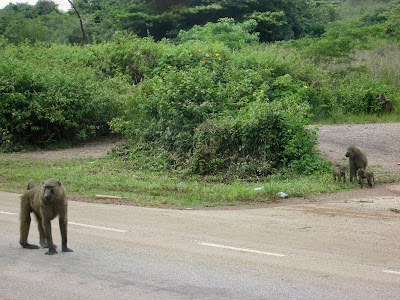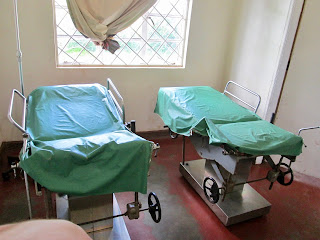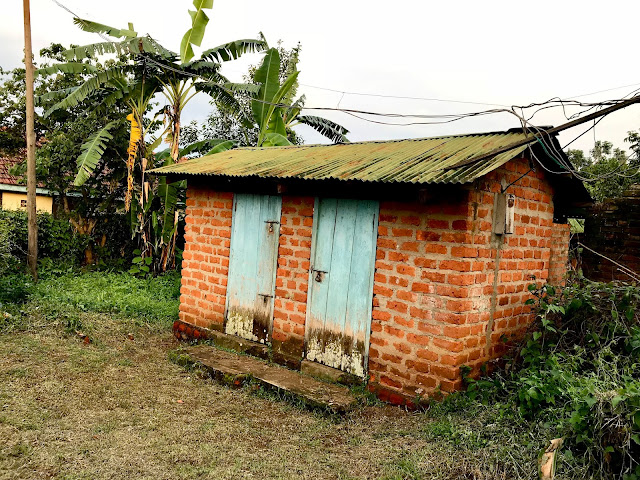https://globalhealtheducators.org/
On April 30th we left for Africa! I went over to Judy’s house, after we had picked up the rental cars for the group to get to the airport, and she and I loaded up our numerous 50 pound supply suitcases. It was, of course, quite a struggle to get all of our baggage through security and weighing at Dulles, but before we knew it we were all on the first leg of our trip-11.5 hours to Istanbul.
On April 30th we left for Africa! I went over to Judy’s house, after we had picked up the rental cars for the group to get to the airport, and she and I loaded up our numerous 50 pound supply suitcases. It was, of course, quite a struggle to get all of our baggage through security and weighing at Dulles, but before we knew it we were all on the first leg of our trip-11.5 hours to Istanbul.
 |
| The PA students and Wilton, just missing Judy and Jim here |
 |
| smaller than the luggage |
The second flight-from Istanbul to Entebbe- was seven hours, although it would’ve been six if the plane hadn’t done a surprise “taxi stop” in Rwanda to pick up more passengers. We arrived in Entebbe at 3:45AM, and waited to receive our checked luggage.
We soon realized that the Uganda customs officers would be taking some of our anesthesia medications. We also had countless scalpels, sutures, and other anesthetics.

On a comedic note : Since there isn’t running water at the Magale convent, where we would be staying, Judy brought with her a large watering can to make a version of a shower. During our packing, we didn’t want the glass vials of medications to be damaged, and so we stored them inside the watering can and other random containers within the suitcase. It was quite ironic to see the customs officers pulling the anesthesia medications out of the packed-full watering can like we were some sort of Ketamine smugglers.
Out we went from the airport to the van and driver Judy had a rented, with all of our supply bags stacked high on little carts. We loaded the bags through the window and we were finally off! The ride from the Entebbe airport to Magale is about 6 hours.
May 2
We rode in Our van as the sun rose towards Jinja. We rode down the 2 lane roads of Africa and past slums of people sleeping outside. We rode on one of the new roads the government of Uganda had just built- but on the wrong side. It was four lanes with a median/ wall in the middle, but the drivers in Uganda apparently thought to drive on it like it was two separate two-lane roads. We had a suspicion that we were going the wrong way, which was confirmed when he pulled up to the toll booth from the wrong side.
 |
| watching us from the side of the road |
We stopped on the way in Jinja, the source of the Nile River, for breakfast.
Next, we were on the road to Bugobero and Magale.
Next, we were on the road to Bugobero and Magale.
We had some baboons charge towards the van, and could see their families and their babies on the side of the road.
 |
| only in Africa... |
We stopped at the little stands on the side of the road and bought some fruit to bring to the convent where we would be staying.
I loved seeing the little houses next to the fruit stands where the owners lived. Their homes were surrounded by papaya, mango, coffee beans, chickens….
This photo of a girl being shy by a tree, with a rooster beside her, is one of my favorites:

This photo of a girl being shy by a tree, with a rooster beside her, is one of my favorites:

Since Wilton was sitting in the front of the van, the Ugandan police could see that we had “Mzungus” (their term for white people). We were repeatedly pulled over by the police so they could ask our group why we were there and where we were traveling. While they were speaking to Wilton, our driver had to hand them his license in addition to paying them off with a bribe through the window.
Our driver drove us through deep mud puddles and passed children on the side of the road guarding the sugarcane they were cutting.
On the way to Magale, we were to stop in Bugobero (another health center nearby) to drop off the suitcase of supplies. Our visit would include consults for any surgeries we would return to do later in the trip. Our driver became a little bit lost on the way, and it took us extra time to find the right dirt road to get us there.

The health clinic was our first taste of tropical Ugandan medicine...We saw the patients and their families standing outside and the operating room- which was basically a table and a few pieces of run down equipment.
 |
| the entrance and sign for the clinic |
The room for deliveries and Neonatal resuscitation was two old rusted metal exam tables with a piece of plastic on top.
The Ugandan doctor we were visiting (who runs this clinic) brought a young boy who had severe facial and full body swelling into the supply closet/exam room for us to see him. His symptoms could only be a form of lymphoma, and since there is no cancer treatment in Uganda (and definitely no surgical biopsies or immunotherapy) the boy would die.
Another boy was brought into the supply closet, this time with a large lipoma of his scalp. Jim said that we’d would be able to excise it, and we told the patient which day we would meet him back here in the clinic the following week. The clinic staff informed us that there was some form of treatment-resistant tuberculosis spreading in the area, and to be careful with patients who have a cough. Their clinic had a "coughing corner"- a particular tree where people with a cough had to sit and wait.
Since we still had several hours remaining on the road, we were at off again towards Magale. By the time I hit 36+ hours of no more than 20 minutes or so of continuous sleep, I finally fell asleep riding in the van on a vigorously bumpy rough dirt road. I thought I heard singing, and I woke up to the schoolchildren’s beautiful songs of welcome. All the children of the school and orphanage (which is connected with the convent & the hospital) had been waiting to welcome us.
We met each one of the nuns, who embraced us with multiple hugs (once on each side of their chest) and showed us to our sleeping area.
 |
| Jim meeting one of the little boys named Innocence |
 |
| Left to right: Sydney, me, Naid, Caroline, Jamie |
 |
| I named him Reginald |
Since we had been traveling since about noon two days before hand, we were all eager to take a “shower.” Because there is only intermittent electricity and water in the area, the nuns bring a yellow bucket of water outside on the ground for bathing. There’s a small strainer to filter out the worms from the brown water.
I developed a “method” of putting my yellow bucket on the bathroom ledge and squatting down on the floor so I could slowly tilt it over my head and wash off soap and shampoo (being careful not to let any of it get into my mouth, nose, or eyes).
We went over to meet the school children and the orphans “next-door.” Every single one of them gave us a tight hug and a warm smile, they were overwhelmingly appreciative to meet us. Each child would ask if they could please hear your name again and again.
The orphans just recently received some form of “mattress” (foam about an inch thick) but before they had nothing like that to sleep on. Most of the children were just wearing plastic shoes or one plastic shoe and were very dirty from their living quarters. The albino orphans, who really love seeing Wilton as he returns each year, weren’t wearing the hats he had given them to protect their skin because they had been taken by the older kids.
 |
| Wilton reuniting with an old friend |
Our first morning waking up in Magale we headed over to the clinic/surgical theater after breakfast to get started.


It’s easy to admire the people of Uganda. These people have nothing in terms of resources, but they are so easy to love and so incredibly kind and appreciative to others. It makes me wonder about what’s missing from the people in America. Our culture is so overly stimulated by excess- an excess of possessions, an excess of food, and an excess of things to do.
We find unhappiness in the stress of our daily lives - whether perceived or actual- and these things are seen, in our view, as hugely overwhelming burdens.
We find unhappiness in the stress of our daily lives - whether perceived or actual- and these things are seen, in our view, as hugely overwhelming burdens.
We’re in a culture so overly stimulated by anything and everything we could possibly need and want that we lose sight of what will really truly make our hearts happy.
Our first day I mostly saw patients in clinic. I was sitting in an exam room with Jim and Patrick while the nurses of the clinic would bring patient after patient into the room. Patrick is a Ugandan doctor in his residency and currently stationed in Magale. He told us the struggles that the government was currently having and how none of the PAs and doctors in Uganda had been paid in months.
The average person cannot physically find medical care in Uganda. In terms of the number of MDs/PAs, there is 1 for every 7,500 people in Uganda… in addition to the barriers of an individual’s lack of transport and resources to get to medical aid. The population of Uganda is growing exponentially- the current estimate is 44 million people, compared with 5 million in 1950. There are 9 optometrists for the whole country.
• Half of the country’s population is below the age of 14.
• 1.4 million people are living with HIV (twice as many women compared to men)
• Life expectancy in Uganda is 57 years, in comparison to 80 years in America.
• Uganda has the highest rate of malaria in the world.
• On average, a woman in Uganda gives birth to six children in her lifetime
Uganda’s medical records are written in a practice notebook for school children (about 20 pages of ruled paper). Each person is expected to carry their health record with them to any sort of medical service. Otherwise, there are no medical records kept in the hospital and certainly no electronic medical record like in America.
The conditions here at the clinic are truly remarkable for surgery...for example, there’s no suction, no cautery to decrease blood loss, and no air ventilation. Surgical gowns and tools are sterilized in buckets with bleach on the floor next to, or inside, the closets (which contain a hole to be used as a toilet).
There is only minimal monitoring of the patient during surgery, only intermittent electricity, and poor lighting. We operated while wearing really powerful headlamps that we brought. Our head lamps would heat up so much during surgery that you could burn yourself by touching it while taking it off.
Another shocking component to surgery in Uganda is the lack of total anesthesia. Judy was teaching the Ugandan doctors how to perform spinal epidurals, but otherwise procedures must be done under injected local anesthetic or just a lot of sedation.
Our team carried backpacks everywhere with our facemasks, sterile gloves, OR scrubs, surgical gowns, and stethoscopes. We couldn't rely on there being any medical materials around that we may need.
There are no blood pressure machines or oxygen saturation monitors. There is no hospital cleaning crew, no nurses coming to patient call buttons. There are no individual patient rooms or privacy drapes from the ceiling- just simple metal beds on the concrete floor. The windows remain open at all times and their glass panes were broken long ago.
A Ugandan must bring their own supplies and bedsheets with them to the hospital; their family is expected to care for them, to wash their clothes/blankets, and to cook their food. Post-surgical patients and new mothers must get up and walk outside to the “bathroom” . Did I mention the hospital was at least 80 degrees the whole time? (and it’s only the rainy season)
A Ugandan must bring their own supplies and bedsheets with them to the hospital; their family is expected to care for them, to wash their clothes/blankets, and to cook their food. Post-surgical patients and new mothers must get up and walk outside to the “bathroom” . Did I mention the hospital was at least 80 degrees the whole time? (and it’s only the rainy season)
We had to adjust to an extreme shift in our approach to medical treatment. Most all medical issues in Uganda are acute or infectious, as opposed to the mainly chronic and self-imposed illnesses (obesity, heart disease, drug abuse, smoking/COPD...) that have entirely overtaken medicine in 1st world countries.
We had to understand, and assimilate with, the shift in cultural practices and understand their culture's comfort with death.
Judy told us that, prior to the Global Health Educators Program’s efforts, if a baby was born and struggled to breathe (this is very common - usually residual fluid in their lungs from circulation within the womb), they would just lay the baby to the side and do nothing. In other words, there were no neonatal resuscitation practices whatsoever.
We were told before coming that if a baby we deliver struggles to breathe with bag ventilation we are to try for just 20 minutes to fix the situation - and then we must move on. Ugandan mothers do not show excitement or attachment to their babies because death rates are so high. Usually, they wait a long time to name their baby. So, when 'us Americans' would ask by instinct what a newborn’s name would be, the mothers usually just ask to use our own name.
Judy told us that, prior to the Global Health Educators Program’s efforts, if a baby was born and struggled to breathe (this is very common - usually residual fluid in their lungs from circulation within the womb), they would just lay the baby to the side and do nothing. In other words, there were no neonatal resuscitation practices whatsoever.
We were told before coming that if a baby we deliver struggles to breathe with bag ventilation we are to try for just 20 minutes to fix the situation - and then we must move on. Ugandan mothers do not show excitement or attachment to their babies because death rates are so high. Usually, they wait a long time to name their baby. So, when 'us Americans' would ask by instinct what a newborn’s name would be, the mothers usually just ask to use our own name.
We had no imaging and no lab values for our diagnosis and treatment. There was no x-ray, no urinalysis, no CT scanner, no MRI. There was one ultrasound machine in the area with a single transducer, but there was no more ultrasound gel to use it.
We had to be creative with our physical exam and use methods that every healthcare provider knows, but never uses, because of all the imaging and labs we use In America.



























No comments:
Post a Comment